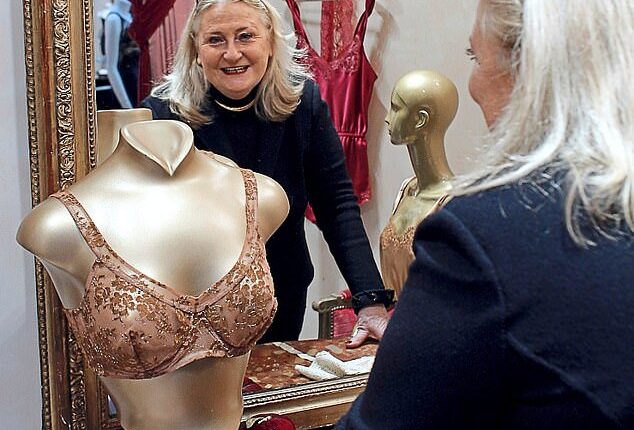It was 2006. I was going to a swanky party and bought a blouse from Selfridges. It was by Chloé, exquisite but slightly see-through.
Underneath it, I would need the perfect nude bra.
I went to Rigby & Peller, corsetière to the late Queen and a big step up from M&S. They gave me three choices, with bumpy seams, ugly straps and chunky fastenings at the back. The cups made me so pointy that the blouse gaped distressingly.
‘Is that it?’ I asked the sales assistant in a small voice, eyes watering. I was so disappointed. I took the top back to Selfridges.
Oh to find the perfect bra! So many lack support, have straps that dig in, pinch from the underwires and flatten or cause bulges in all the wrong places. But then… a friend told me she’d visited Cadolle, a couture house in Paris that was dedicated entirely to the noble art of underpinnings. I listened, rapt, as she described the fitting, the toile, the selection of lace, and the perfect fit.

Poupie pictured in her Paris couture salon, 2010

Gwendoline Christie in a Cadolle corset on the Maison Margiela Couture catwalk, 2024
Then she told me the price: her bra cost – gulp – 600 euros (£400). But she was so clearly thrilled by the experience, I was instantly persuaded. How do I get one?
Next day, I phoned Madame Cadolle and arranged a visit for the following month.
Paris, late October 2006. I travelled with my husband and three-year-old daughter (who, unknown to us, was brewing chickenpox). It was the ideal excuse for a family break and we checked into a lovely hotel on the Champs-Élysées, already sparkling with early Christmas lights.
Next day, we strolled past the Tuileries, the Ritz, the legendary fashion houses of Chanel and Saint Laurent on the rue Saint-Honoré, down a little side passage and through Cadolle’s wooden door.
Nearly two decades on, I still remember perching on the red velvet sofa to meet Madame Cadolle, whom I’ve known ever since as Poupie, the name she’s gone by since childhood. Super-chic in her trademark black, blonde shoulder-length hair, red nails, she’s in her late 70s these days, wonderfully maternal, warm, smiley – and very funny.
Cadolle was founded in the late 1880s by Poupie’s great-great-grandmother, Herminie Cadolle, inventor of the modern bra.
Briefly jailed for her involvement in the Paris Commune, Herminie was a corset maker who was also a feminist. She intended the bra to liberate women from restrictive clothing and achieved it by literally cutting a corset in two. She unveiled this new, patented invention – the corselet-gorge – during 1889’s World Fair.
It was a huge success. ‘She forgot all about her political ideals and became a capitalist, very rich!’ laughs Poupie, who still owns Herminie’s early product sketches.
The company worked with Coco Chanel to shape her boyish silhouette and last year John Galliano called on Cadolle to create corsets for his acclaimed Maison Margiela couture show (opposite).
Over the decades, private clients have included the Duchess of Windsor, the exotic dancer/spy Mata Hari and the actress Elizabeth Taylor.
Many clients have their identity concealed behind initials or code numbers known only to Poupie. More recent customers include Beyoncé (who wore the Cadolle Cage corset for one of her videos) and Monica Bellucci (her corset in the Bond film Spectre was designed by Poupie). Lady Gaga wore Cadolle as part of her Dior outfit for her Paris 2024 Olympics opening ceremony performance.
But Cadolle remains a small family business, with just 11 employees working across couture. Through six generations it has passed from mother to daughter: Herminie, Marie, Marguerite, Alice, Poupie, and now Poupie’s daughter Patricia.
New customers are given Poupie’s full attention, in conversations that can last a long time. She tells me that a recent chat with a client about the width of her bra straps lasted an hour and half. ‘I ask why [the customer] has come to see me,’ Poupie says.
‘Are her bras uncomfortable? Does she dislike the shape or the way they move? I ask why she’s chosen couture, because couture is expensive. I want to understand what she’s expecting from me.’
There are around 25 different styles in her collection. Whichever the customer chooses will be adapted over several fittings until it’s perfect. Each person has her own pattern.

The Carat bra was originally made for a dancer
Modern seamless bras are moulded on machines, using heat. Poupie’s use stiff lace – beautiful, delicate, but strong – and strategic darts to provide support and shape. ‘If you have a stretchy moulded bra, you’re killing your bust!’ Poupie says theatrically, as we talk this week on FaceTime.
The same goes for bras with elastic in the straps as they allow too much movement in the breasts. She throws her hands up in the air. ‘Terrible!’
I knew at once which bra would work for me: the Carat. Poupie designed it years ago for a dancer called Cara (the ‘t’ was added later as the bra is a diamond to Poupie).
‘She was so difficult! Dancers are the most demanding women in the world. But I made the perfect bra for her, and it happens to be one of the most perfect bras for everybody!’
It can be made pointy, she says, or round, flattening or enhancing. It can minimise or create more shape by adjusting the side seams. Once I’d chosen the style I wanted and the look (natural, not at all pointy), the real work began. In the downstairs atelier, a small team of seamstresses focus on the intricate stitching, surrounded by drawers filled with lace, tulle and ribbons in every colour.
If the first version doesn’t fit perfectly? ‘We cut a new one,’ says Poupie. ‘The first fitting is mostly for me. The customer often doesn’t like it because there are big seams and rough fabrics, so I reassure her that it will be fine. The bra is covered in pins, then the pattern maker unpicks it completely and flattens it to make the new pattern.’

An 1889 sketch of the groundbreaking corselet-gorge
I went away for two days, then came back. The bra had been roughly stitched together and Poupie made further adjustments while my daughter – now fully in the grip of her chickenpox – screamed down the private salon as my poor husband tried to keep her quiet.
At the second fitting, every seam, strap and piece of elastic can still be adjusted. ‘Then, when we agree it fits, we finish the final bra,’ says Poupie. And trimmings are added: embroidery along the top stops it cutting into my skin, one side of the wire is adjusted to avoid touching a small mole, and the straps have a velvety underside.
My first Cadolle bra – in a frothy pale-pink lace named Pétale de Rose – arrived a few weeks later, wrapped in exquisite tissue paper with a gold Cadolle sticker. The receipt was written in beautiful French curly script.
It was perfect! Delicate, super-pretty but so supportive I could run a marathon in it. And it moulded to my body so precisely, so smoothly that I forgot it was there. All my clothes fitted better when I was wearing it, from the scruffiest T-shirt to the chicest dress.
Almost 20 years have passed, and I’ve ordered a few more bras since then. I don’t go around telling everyone but when I do, I’m met with surprise and curiosity. A couture bra carries a touch of glamour from the golden age before fast fashion. Others splurge on designer handbags and jewellery, which do little for me. Simply feeling comfortable and having something beautiful to wear every day is a far greater pleasure.
I love to look at old messages to and from Poupie, always full of fun, warmth and friendship. She has often come to London, where we meet in hotels for new fittings or to make adjustments. Once, she came only for a day so we went into Liberty, picked up a handful of clothes from the rails and fitted my bra in the changing room. (Sorry, Liberty!)

Mata Hari wearing Cadolle corsetry, 1900
That first bra, in 2006, cost 600 euros (£400 at the exchange rate of the time).
Now they start at more than 1,000 euros (£900). I’ve come up with a clever mathematical formula to justify the expense.
Over 19 years, I’ve had six Cadolle bras. That’s one every 3.1 years. They are all the Carat, in pale pink or nude, perfectly matched to my skin tone so they go with everything (super cost-effective!).
I wear only that one bra, on repeat, washing it lovingly each week in hair shampoo (as advised by Poupie). She repairs my bras – new straps, new elastic at the back – to keep them going longer and I still possess every one. I wear the old ones for gardening or walking the dog. Not one has ever ended up in the bin (an environmental win!).
When I travel I take them in hand luggage. I can’t risk my bras going missing. (I’m not the only one. Another customer does exactly the same thing, Poupie tell me: ‘She treasures them like jewellery.’)
I do worry, since Brexit, each time Poupie posts back a bra she’s repaired. Will I be hit by import tax or, worse, will the bra languish in customs and get lost?
Last year Poupie returned a bra I’d asked to be tweaked. The delivery person put it through the wrong door. That house was being renovated and the owners were abroad for months. Quelle horreur!

The Paris store front
I sent out a panicked alert on our neighbourhood WhatsApp group. ‘Help!’ I wrote. ‘A really urgent package has been delivered to number five. Does anyone know what to do?’
A flurry of messages from the owners abroad. Then a super-kind neighbour I’d never spoken to before said he had a spare key, and rushed round to rescue my precious parcel. I said the biggest thank you when he handed me the anonymous white padded envelope, but I confess that I kept to myself what it actually contained.
Poupie has since met my now very well-behaved adult daughter and always asks fondly about her. One day I hope she will also have the pleasure of owning a handmade Cadolle bra.








